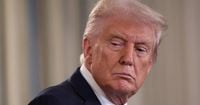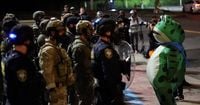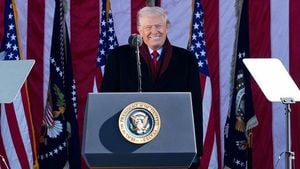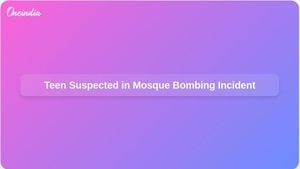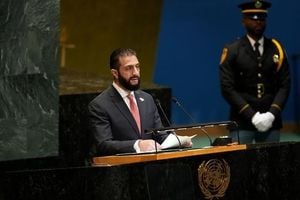As the federal government shutdown grinds through its fourth day, President Donald Trump’s administration has unleashed a sweeping campaign of funding freezes and aid cuts, targeting Democratic-led cities and states with a scale and intensity rarely seen in modern American politics. The latest salvo came Friday, October 3, 2025, when the White House abruptly froze $2.1 billion in federal funds earmarked for Chicago’s long-anticipated Red Line extension and Red and Purple Line modernization transit projects. This move, announced by federal budget director Russ Vought, is just one part of a broader pattern of retribution and political brinkmanship that has left local leaders scrambling and residents anxious about the future of essential infrastructure.
According to Capitol News Illinois, the decision to halt Chicago’s funding was publicly justified by Vought as a measure to “ensure funding is not flowing via race-based contracting.” The U.S. Department of Transportation followed up with letters to the Chicago Transit Authority, signaling a review of the projects’ contracting requirements for constitutional compliance. The department specifically cited the city’s efforts to meet disadvantaged business contracting goals, noting that as of November 2024, 21% of spending on the Red-Purple Modernization projects went to 119 firms qualifying under disadvantaged business criteria. “Illinois, like New York, is well known to promote race- and sex-based contracting and other racial preferences as a public policy,” the DOT stated. “The American people don’t care what race or gender construction workers, pipefitters, or electricians are. They just want these massive projects finally built quickly and efficiently.”
For Illinois Democrats, the funding freeze is more than a bureaucratic pause—it’s a direct threat to economic growth and daily life. Senator Dick Durbin took to the Senate floor to warn that the Red Line extension project, expected to expand transit access to 100,000 people and create tens of thousands of jobs, would now face significant delays. “This project will expand transit access to 100,000 people. It will be an economic boost for the city and create tens of thousands of jobs for working families,” Durbin said. Governor JB Pritzker was even more blunt, blasting the move as a “vindictive abuse of power” and accusing Trump of “holding bipartisan funding hostage.” In a statement posted on social media, Pritzker argued, “It’s attempting to score political points but is instead hurting our economy and the hardworking people who rely on public transit to get to work or school.”
Chicago is not alone in feeling the sting. Earlier in the week, the Trump administration announced it would withhold a staggering $18 billion in previously awarded infrastructure funds from New York City, stalling major projects like the Hudson Tunnel Project and the Second Avenue subway. According to The New York Times, the rationale was again tied to concerns over “unconstitutional DEI principles”—the now-familiar shorthand for diversity, equity, and inclusion. New York Governor Kathy Hochul did not mince words: “We are definitely being punished, not just for being a blue state but for being the home of the leaders.” She emphasized that her state had spent “decades of waiting and waiting and waiting” for the promised funds.
But the cuts did not stop at transit. On Thursday, October 2, the federal government froze $583 million in funding for Illinois energy projects, affecting 33 initiatives involving major institutions like Exelon, the University of Illinois, and Northwestern University. The funds were slated for grid reliability, carbon capture technology, and other critical modernization efforts, as detailed in documents released by Senator Tammy Duckworth. The administration also stripped nearly $7.6 billion in green-energy funding from 223 projects across 16 states, most of them Democratic strongholds, with White House budget director Russell T. Vought dismissing the programs as “Green New Scam funding to fuel the Left’s climate agenda.”
For many observers, the timing and focus of these funding cuts leave little doubt about their political motivations. As reported by NBC News, President Trump has directed his team to identify potential further cuts to federal aid for Portland, Oregon, another Democratic bastion. These moves follow a consistent pattern since the shutdown began: targeting blue states and cities for punitive financial measures, while leveraging the crisis to pressure Democrats into accepting the administration’s demands.
Legal experts and watchdog groups have raised alarms about the unprecedented nature of the administration’s actions. Matthew Lawrence, a law professor at Emory University interviewed by The New York Times, remarked, “I can’t think of a historical parallel of an administration publicly cutting funds in a shutdown like this.” Cerin Lindgrensavage, a lawyer at Protect Democracy, cautioned Americans to be “skeptical of stated reasons” for the funding decisions, citing a pattern of interference with congressionally enacted funds. The Government Accountability Office has already determined that the administration repeatedly violated laws prohibiting presidents from impounding money appropriated by Congress, and is reportedly preparing for potential legal action.
On the ground, the consequences are immediate and deeply felt. The Chicago Transit Authority confirmed it had received the federal letters and was reviewing them, but the uncertainty has already cast a pall over ongoing and future projects. The Red Line extension, in particular, was seen as a linchpin for connecting underserved neighborhoods to economic opportunity. Meanwhile, the energy funding freeze threatens to derail advances in grid resilience and clean technology, with ripple effects likely to be felt across the Midwest and beyond.
Illinois Attorney General Kwame Raoul has attempted to fight back, winning two injunctions in recent months against Trump administration efforts to withhold funding based on the state’s immigration policies. Yet, the sheer scale of the current freezes—totaling more than $27 billion in halted or canceled federal aid since the shutdown began—has left many state and local officials feeling outmatched and frustrated. “President Donald Trump wants to punish states like Illinois, and the people who live there, because they didn’t vote for him in the last election,” Senator Durbin charged from the Senate floor. “Freezing funds for these projects is a blatant abuse of power by a president and an administration that would rather settle petty personal scores than actually help people.”
Republican leaders, for their part, have largely rallied behind the White House, placing blame for the shutdown and its consequences squarely on the Democrats. House Speaker Mike Johnson of Louisiana argued, “What they have to do is make very difficult decisions,” and insisted that Vought “takes no pleasure in this.” The White House, meanwhile, has maintained that the funding reviews are necessary to safeguard taxpayer dollars and eliminate waste, with press secretary Karoline Leavitt saying, “We have to conduct a massive review of the bureaucracy to be good stewards of the American taxpayer dollar.”
Yet, as lawsuits mount and the standoff drags on, the real losers are the millions of Americans caught in the crossfire—commuters, workers, students, and families who depend on robust public infrastructure and reliable energy. With the shutdown showing no signs of resolution and the administration signaling further cuts on the horizon, the political battle over federal funding has become a high-stakes test of power, legality, and the very meaning of government accountability in 2025.
